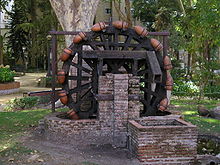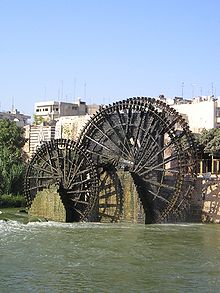- Noria
-
For the member of the J-pop group BeForU, see Noria Shiraishi.
A noria (Arabic: ناعورة, nā‘ūra, from Syriac: ܢܥܘܪܐ, nā‘urā) is a machine for lifting water into a small aqueduct, either for the purpose of irrigation or, in at least one known instance, to feed seawater into a saltern.There are three types of noria. The most common examples consist of a vertical wheel which is slung with a chain of buckets. The buckets hang down into a well which may be up to 8 m (26 ft) deep. The most primitive norias of this type are driven by donkeys, mules, or oxen. The animal turns another wheel, which is engaged with the noria and so causes it to turn. This causes the buckets to circulate.
A second type of noria uses the same system, of a necklace of clay or wooden buckets, but it is driven by the wind. The wind driven norias in the vicinity of Cartagena, Spain, are virtually identical in appearance with the local grinding mills.
The third type of noria uses the energy derived from the flow of a river. It consists of a large, very narrow undershot waterwheel whose rim is made up of a series of containers which lift water from the river to a very small aqueduct at the top of the wheel.
Unlike the water wheels found in mills, a noria does not provide mechanical power to any other process. Its concept is similar to the modern hydraulic ram, which also uses the power of flowing water to pump some of the water out of the river.[1]
A few norias were hybrids, consisting of an animal-driven waterwheel.
A noria can raise water to somewhat less than its full height. The largest noria in the world, with a diameter of about 20 meters, is located in the Syrian city of Hama.
It performs a similar function to chain pumps (including the saqiya), and other pumps, that of moving water from a lower elevation to a higher elevation, but these are generally powered by other means, not by a waterwheel.
The undershot and overshot waterwheel, both animal and water-driven, and with either a compartmented body (Latin tympanum) or a compartmented rim were invented by Greek engineers between the 3rd and 2nd century BC.[2] Around 300 AD, the Romans replaced the wooden compartments with separate, attached ceramic pots that were tied to the outside of an open-framed wheel, thereby creating the noria.[3]
Norias were adopted during the Arab Agricultural Revolution and were in large-scale use in the medieval Islamic world,[4] where Muslim inventors and engineers made a number of improvements to the noria.[5] For example, the flywheel mechanism used to smooth out the delivery of power from a driving device to a driven machine, was invented by Ibn Bassal (fl. 1038-1075) of al-Andalus, who pioneered the use of the flywheel in the noria and chain pump (Sakia or saqiya).[6] In 1206, Al-Jazari introduced the use of the crankshaft in a noria and saqiya, and the concept of minimizing intermittent working was implied for the purpose of maximising their efficiency.[7]
Muslim engineers used norias to discharge water into aqueducts which carried the water to towns and fields.[4] Some of the norias used in the medieval Islamic world were as large as 20 meters in diameter, the norias at Hama being a surviving example still used in modern times (although currently only serving aesthetical purposes). It has 120 water collection compartments and could raise more than 95 litres of water per minute.[1] Muhammad ibn Zakariya al-Razi's Kitab al-Hawi in the 10th century describes a noria in Iraq that could lift as much as 153,000 litres per hour, or 2550 litres per minute. This is comparable to the output of modern Norias in East Asia which can lift up to 288,000 litres per hour, or 4800 litres per minute.[8]
During the period of agricultural expansion in Song China, the technology of norias was improved. For some centuries they had been used for moving water for drainage or irrigation purposes. The simplest design, such as the counterbalanced bucket or 'well-sweep' was found almost universally. A more complicated design, the 'square-pallet chain pump' was introduced several centuries before the growth in Song technology, but had not been used until then for farming. They became more common around the end of the first millennium AD.[9]
The contribution of norias to agricultural growth during the Song was extolled by poets such as Li Ch'u-ch'uan (李处权) of the twelfth century. The Song government actively spread the technology, introducing pumping equipment and norias to those areas as yet unfamiliar with the techniques.[10]
See also
- Sakia
- Scoop wheel
References
- ^ a b "Machines of the East". Ancient Discoveries. History Channel. No. 10, season 3. Retrieved on 2008-09-07.
- ^ Oleson 1984, pp. 325ff.; Oleson 2000, pp. 217–302; Donners & Waelkens 2002, pp. 10−15; Wikander 2000, pp. 371−400
- ^ Oleson 1984, pp. 337f., 366−368; Oleson 2000, pp. 235
- ^ a b Donald Routledge Hill (1996), "Engineering", in Roshdi Rashed, Encyclopedia of the History of Arabic Science, Vol. 3, p. 751-795 [775].
- ^ Thomas F. Glick (1977), "Noria Pots in Spain", Technology and Culture 18 (4), p. 644-650.
- ^ Ahmad Y Hassan, Flywheel Effect for a Saqiya.
- ^ Donald Routledge Hill, "Engineering", in Roshdi Rashed (ed.), Encyclopedia of the History of Arabic Science, Vol. 2, pp. 751-795 [776], Routledge, London and New York
- ^ Donald Routledge Hill (1996). A history of engineering in classical and medieval times. Routledge. pp. 145–6. ISBN 0415152917.
- ^ Elvin, Mark (1973). The Patterns of the Chinese Past. Stanford University Press. p. 126. ISBN 0-8047-0876-2.
- ^ Elvin, Mark (1973). The Patterns of the Chinese Past. Stanford University Press. p. 127. ISBN 0-8047-0876-2.
Further reading
- Donners, K.; Waelkens, M.; Deckers, J. (2002), "Water Mills in the Area of Sagalassos: A Disappearing Ancient Technology", Anatolian Studies (British Institute at Ankara) 52: 1–17, doi:10.2307/3643076, JSTOR 3643076
- Oleson, John Peter (1984), Greek and Roman Mechanical Water-Lifting Devices: The History of a Technology, University of Toronto Press, ISBN 90-277-1693-5
- Oleson, John Peter (2000), "Water-Lifting", in Wikander, Örjan, Handbook of Ancient Water Technology, Technology and Change in History, 2, Leiden: Brill, pp. 217–302
- Wikander, Örjan (2000), "The Water-Mill", in Wikander, Örjan, Handbook of Ancient Water Technology, Technology and Change in History, 2, Leiden: Brill, pp. 371–400, ISBN 90-04-11123-9
External links
Categories:- Aqueducts
- Pumps
- Irrigation
Wikimedia Foundation. 2010.


